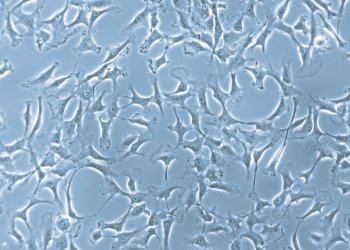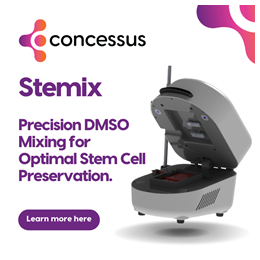You are here
Growing MSC in Bioreactors: Part 3. Growth Medium
During the development of a manufacturing process for MSC production on a large scale, decisions are made in an effort to optimize cell yield and cell quality, as discussed in Part 1 and Part 2 of this series. One of the most critical decisions is the growth medium formulation to be used during the expansion process. Several options for medium formulation are currently available on the market.
 Medium supplemented with fetal bovine serum (FBS) was routinely used in the past, especially in academic scenarios. Although FBS is known to contain several growth factors that promote cell proliferation, FBS also can introduce several problems. The lack of consistency between batches of serum, together with the potential risk of contamination with prions, are only two disadvantages of using FBS. Adding to that list is the limited supply of GMP-certified FBS suppliers worldwide. One important detail to keep in mind is that although FBS has disadvantages, its use for cell and gene therapy is not banned as long as it respects the regulatory guidelines for serum use in this field [1], [2].
Medium supplemented with fetal bovine serum (FBS) was routinely used in the past, especially in academic scenarios. Although FBS is known to contain several growth factors that promote cell proliferation, FBS also can introduce several problems. The lack of consistency between batches of serum, together with the potential risk of contamination with prions, are only two disadvantages of using FBS. Adding to that list is the limited supply of GMP-certified FBS suppliers worldwide. One important detail to keep in mind is that although FBS has disadvantages, its use for cell and gene therapy is not banned as long as it respects the regulatory guidelines for serum use in this field [1], [2].
To avoid using FBS, human alternatives have been explored such as human serum (hS) and human platelet lysate (hPL). Both hS and hPL are blood-derived products that follow different bioprocessing routes. Whereas hS is obtained after several centrifugation cycles once peripheral blood is allowed to clot, hPL uses plasma that was further submitted to freeze and thaw cycles [3]. While these options remove the dependency on bovine products, hS and hPL are still products that do not offer batch to batch consistency as there is biologic variability between donors.
 The next step towards manufacturing consistency is to use xenofree (XF), serum-free (SF), or a chemically defined medium. Xenofree medium is an option that does not contain products from animal origin. By removing the presence of animal-derived components, batch to batch consistency is expected to increase. However, different medium formulations can have different impact on MSC growth and characterization, so that switching to a xenofree medium does not solve all manufacturing concerns.
The next step towards manufacturing consistency is to use xenofree (XF), serum-free (SF), or a chemically defined medium. Xenofree medium is an option that does not contain products from animal origin. By removing the presence of animal-derived components, batch to batch consistency is expected to increase. However, different medium formulations can have different impact on MSC growth and characterization, so that switching to a xenofree medium does not solve all manufacturing concerns.
In 2015, Heathman et al published that SF medium was able to guarantee better process consistency than FBS supplemented serum. In that study the impact on growth kinetics of 5 different donors of MSC was reduced by using a SF medium formulation [4]. It was also reported that MSC expanded with XF and hPL supplemented medium exhibit higher proliferation ability than FBS-based medium [5]–[7], both in tissue culture flask and for bioreactor scale. It has also been reported that SF medium enhanced the clonogenic potential of MSC and increases the consistency of the secretome from these cells [8], [9].
To summarize, when the goal is to expand MSC, medium formulation is key as it impacts both cell growth kinetics and potency. Process consistency is critically affected depending on the medium formulation. Ultimately, different medium formulations will have to go through different regulatory approval steps to ensure the safety of the components used during the expansion process.
References
- EMA, “Guideline on the use of bovine serum in the manufacture of human biological medicinal products,” Committee for Medicinal Products for Human Use (CHMP), 2013. [Online]. Available: http://www.ema.europa.eu/docs/en_GB/document_library/Scientific_guidelin....
- M. Cimino, R. M. Gonçalves, C. C. Barrias, and M. C. L. Martins, “Xeno-free strategies for safe human mesenchymal stem/stromal cell expansion: Supplements and coatings,” Stem Cells International, vol. 2017. 2017.
- K. Bieback et al., “Human alternatives to fetal bovine serum for the expansion of mesenchymal stromal cells from bone marrow,” Stem Cells, vol. 27, no. 9, pp. 2331–2341, 2009.
- T. R. J. Heathman et al., “Serum-free process development: Improving the yield and consistency of human mesenchymal stromal cell production,” Cytotherapy, vol. 17, no. 11, pp. 1524–1535, 2015.
- C. Martin, A. Piccini, I. Chevalot, E. Olmos, E. Guedon, and A. Marc, “Serum-free media for mesenchymal stem cells expansion on microcarriers,” BMC Proc., vol. 9, no. Suppl 9, p. P70, 2015.
- Q. A. Rafiq et al., “Process development of human multipotent stromal cell microcarrier culture using an automated high-throughput microbioreactor,” Biotechnol. Bioeng., vol. in press, Jul. 2017.
- I. N. Simões et al., “Human mesenchymal stem cells from the umbilical cord matrix: successful isolation and ex vivo expansion using serum-/xeno-free culture media.,” Biotechnol. J., vol. 8, no. 4, pp. 448–58, Apr. 2013.
- T. R. J. Heathman et al., “Scalability and process transfer of mesenchymal stromal cell production from monolayer to microcarrier culture using human platelet lysate,” Cytotherapy, vol. 18, no. 4, pp. 523–535, Apr. 2016.
- P. Swamynathan et al., “Are serum-free and xeno-free culture conditions ideal for large scale clinical grade expansion of Wharton’s jelly derived mesenchymal stem cells? A comparative study,” Stem Cell Res. Ther., vol. 5, no. 4, 2014.



